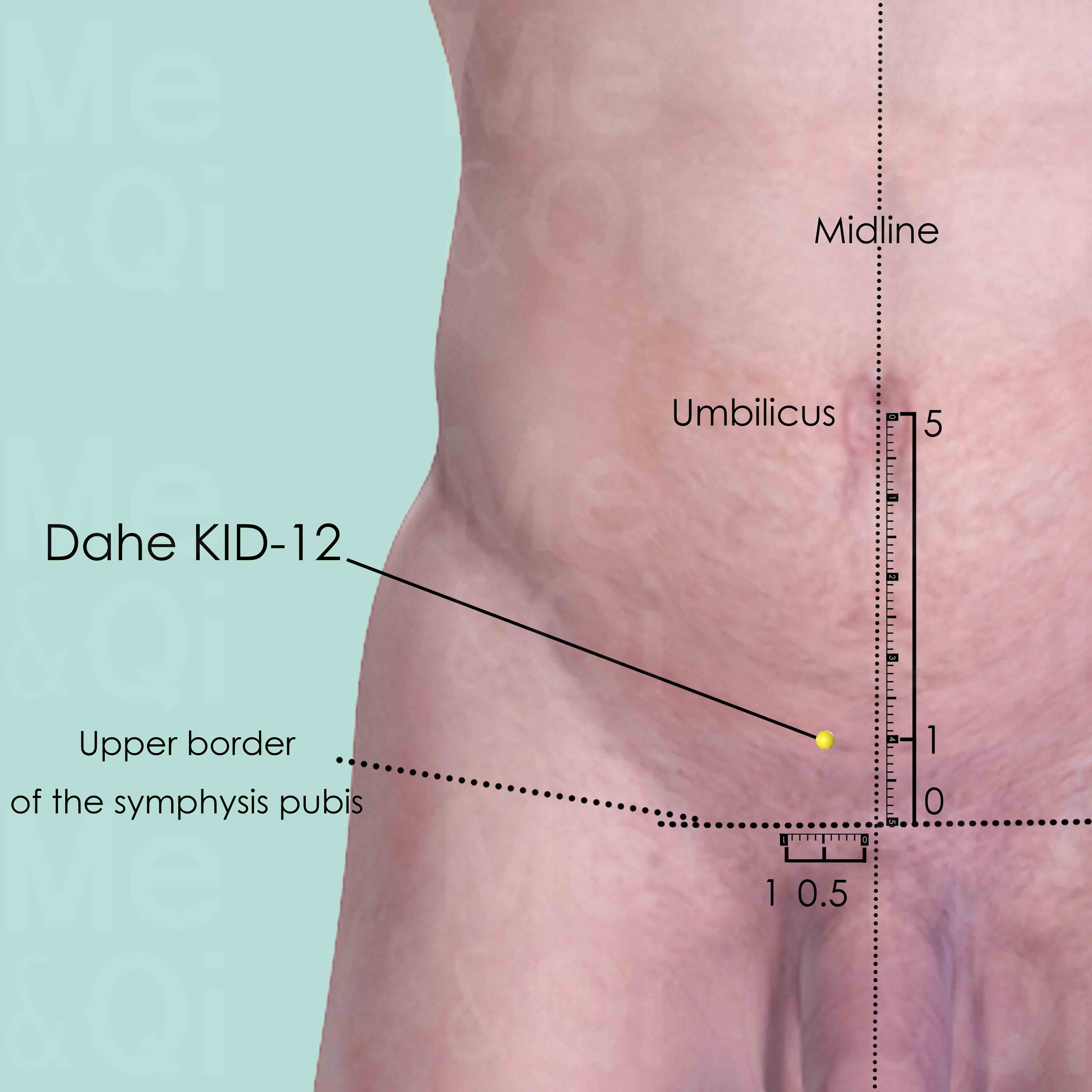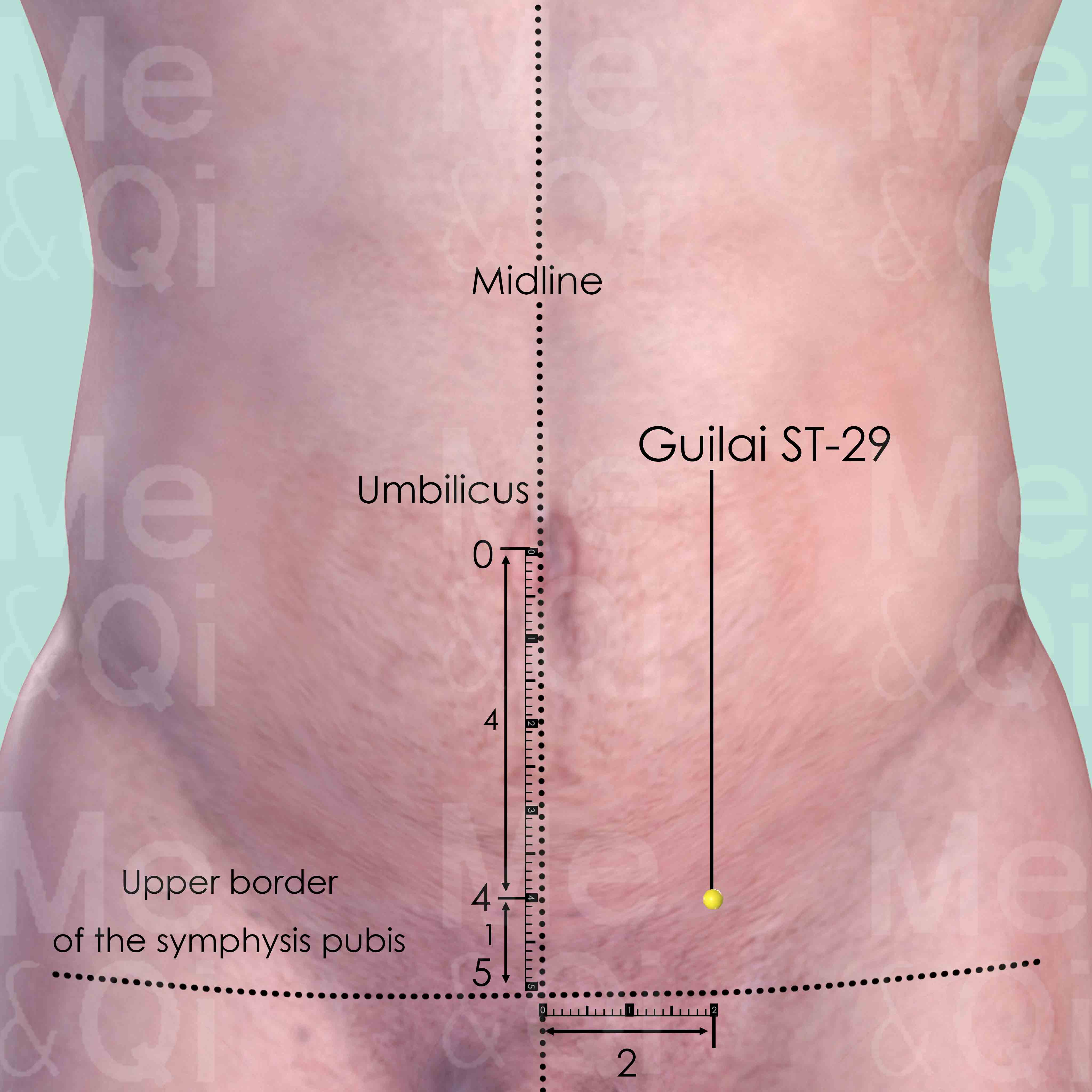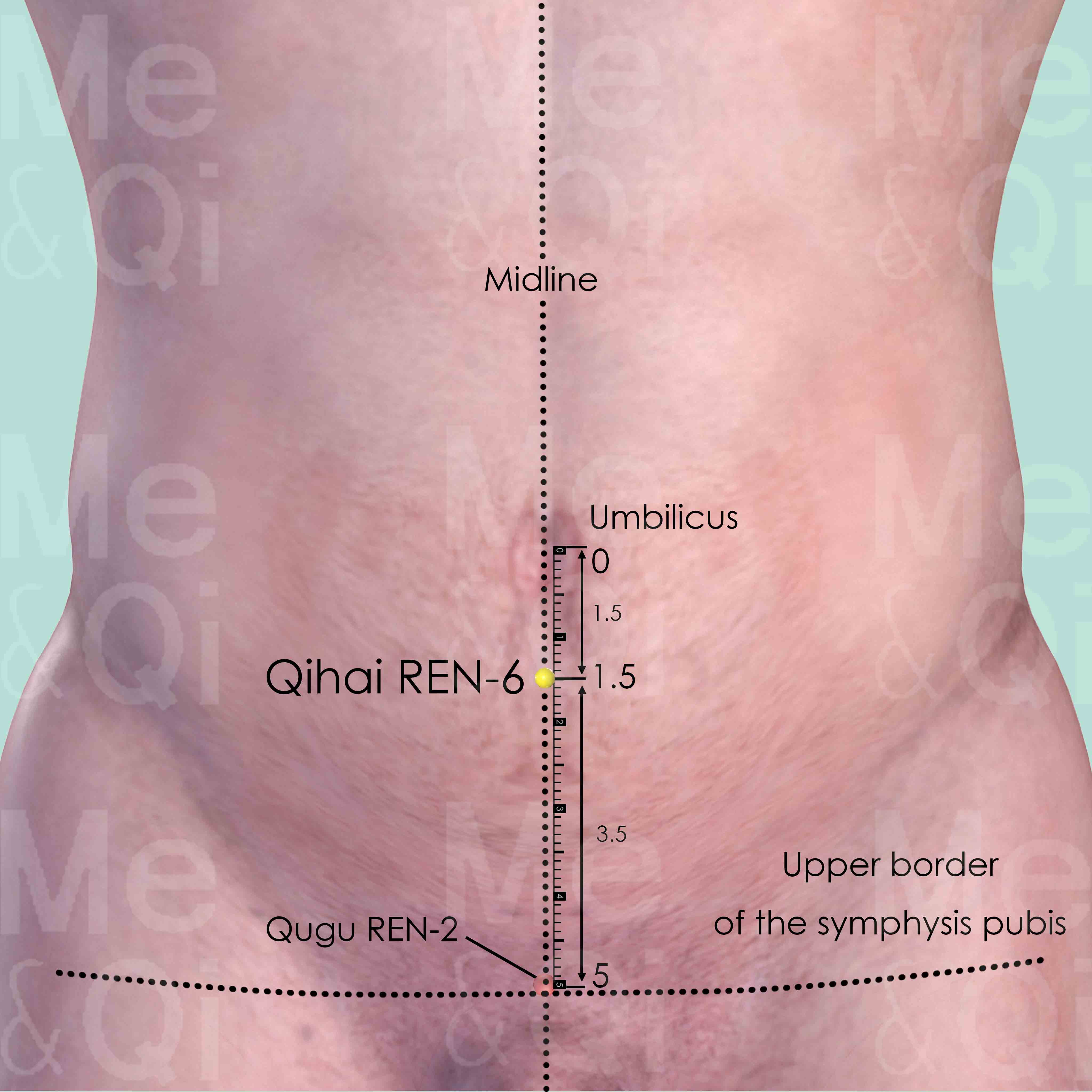Uterine Prolapseaccording to TCM
Symptom family: Gynecological Conditions
Did you mean? Vaginal Prolapse
What is Uterine Prolapse?
Uterine prolapse occurs when the uterus descends from its normal position into the vaginal canal, resulting from the weakening of the pelvic floor muscles and ligaments that support it.
This condition can lead to symptoms such as a sensation of heaviness or pulling in the pelvis, discomfort or pain during intercourse, urinary problems, and visible protrusion of the uterus through the vaginal opening. Uterine prolapse can significantly affect a woman's quality of life, making early diagnosis and management essential.
How does TCM view Uterine Prolapse?
In Traditional Chinese Medicine (TCM), uterine prolapse is understood through the concept of patterns, which are specific constellations of symptoms and signs reflecting an underlying imbalance. Recognizing these patterns is fundamental because it guides the selection of a tailored treatment strategy.
TCM believes that effective treatment hinges on correcting the root imbalance rather than just addressing the symptoms. Therefore, identifying the precise pattern behind uterine prolapse is essential for restoring harmony and health according to TCM principles.
Root Causes of Uterine Prolapse in TCM
TCM attributes uterine prolapse primarily to Qi Sinking and Qi Deficiency, with particular emphasis on the Spleen and Kidney systems. Qi Sinking, a condition where the body's vital energy weakens and moves downward, can lead to prolapse of the Uterus and other pelvic organs.
Additionally, Qi Deficiency, especially of the Spleen and Kidney, undermines the body's structural support, contributing to the weakening of muscles and ligaments necessary for uterine support. These TCM perspectives highlight the importance of nurturing Qi to prevent and treat uterine prolapse.
Explore below more details about what might cause Uterine prolapse according to TCM.
- By Syndrome
- By Organ
- Qi Sinking
- Qi Deficiency
- Kidney
- Spleen
Qi Sinking
Qi Sinking is a pattern of disharmony in TCM where the body's energy, or Qi, is thought to "sink" or drop down. Imagine a balloon slowly deflating and falling; that's similar to what happens with Qi Sinking. This can lead to feelings of heaviness, fatigue, and even physical symptoms like prolapse of organs or frequent urination. It's as if the body's energy, which usually supports and holds things in place, isn't able to do its job properly. TCM views this as an imbalance where the uplifting and supporting qualities of Qi are weakened.... see more
Qi Sinking Patterns That Can Lead to Uterine Prolapse
Common Symptoms: Prolapsed Bladder Stomach Prolapse Anus Prolapse Hemorrhoids Generalized Fatigue Lack Of Appetite Diarrhea Depression
| Pattern Name | Relevant Symptoms | Relevant Formulas |
|---|---|---|
| Qi Collapsing or Qi Sinking | Uterus prolapse, Uterine prolapse, Prolapsed bladder, Stomach prolapse, Nephroptosis, Anus prolapse, Bearing down sensation in abdomen, Hemorrhoids, Chronic diarrhea, Frequent and urgent urination, Urinary incontinence, Generalized fatigue, Low energy, Intestines prolapse, Vaginal prolapse... see more | Bu Zhong Yi Qi Tang | Du Shen Tang |
| Spleen Qi Sinking | Uterus prolapse, Lack of appetite, Slight abdominal distension after eating | Bu Zhong Yi Qi Tang |
Qi Deficiency
Qi Deficiency in TCM is like running low on battery power. Qi is the vital energy that powers every function in your body. When there's a Qi Deficiency, it means your body doesn't have enough of this essential energy. This can make you feel tired all the time, weak, or even cause shortness of breath. It's similar to how you feel when you haven't had enough sleep or nutritious food. Your body just doesn't have the energy it needs to perform at its best. Unlike modern medicine, which often focuses on specific physical causes for fatigue and weakness, TCM views Qi Deficiency as an overall energy depletion that affects your entire well-being, and it seeks to replenish and balance this vital energy.... see more
Qi Deficiency Patterns That Can Lead to Uterine Prolapse
| Pattern Name | Relevant Symptoms | Relevant Formulas |
|---|---|---|
| Kidney Qi not Firm | Uterus prolapse, Lower back pain, Lower back weakness, Polyuria, Weak urine stream, Enuresis, Nocturnal emission, Generalized fatigue, Chills, Cold extremities, White vaginal discharge, Bearing down sensation in abdomen, Recurrent miscarriage... see more | You Gui Wan | Jin Suo Gu Jing Wan | Fu Tu Dan | Qing E Wan | Tu Si Zi Wan |
Kidney
In TCM the Kidneys are regarded as the body's most fundamental reservoir of Essence, known as Jing, which influences growth, reproduction, and aging. They are not just organs for filtering blood, but a holistic system governing vital life forces. When the Kidneys malfunction in TCM, it can manifest as a variety of health issues, such as chronic fatigue, reproductive problems, imbalances in fluid metabolism leading to edema or dryness, lower back pain, and a sense of fear or insecurity.... see more
Kidney Patterns That Can Lead to Uterine Prolapse
| Pattern Name | Relevant Symptoms | Relevant Formulas |
|---|---|---|
| Kidney Qi not Firm | Uterus prolapse, Lower back pain, Lower back weakness, Polyuria, Weak urine stream, Enuresis, Nocturnal emission, Generalized fatigue, Chills, Cold extremities, White vaginal discharge, Bearing down sensation in abdomen, Recurrent miscarriage... see more | You Gui Wan | Jin Suo Gu Jing Wan | Fu Tu Dan | Qing E Wan | Tu Si Zi Wan |
Spleen
In TCM the Spleen plays a vital role in digestion and transformation, converting food into energy and nutrients, and overseeing the distribution of Qi and Blood. It's also crucial in maintaining the health of muscles and limbs and ensuring the blood remains within the vessels. When the Spleen malfunctions in TCM, it can lead to a variety of issues such as digestive disorders, fatigue, weak muscles, bloating, and a feeling of heaviness. It can also cause a pale complexion, poor appetite, and a tendency to bruise easily. Emotionally, a Spleen imbalance is often associated with excessive worry or overthinking, reflecting its role in the interplay between physical and mental health.... see more
Spleen Patterns That Can Lead to Uterine Prolapse
| Pattern Name | Relevant Symptoms | Relevant Formulas |
|---|---|---|
| Spleen Qi Sinking | Uterus prolapse, Lack of appetite, Slight abdominal distension after eating | Bu Zhong Yi Qi Tang |
TCM Herbal Formulas for Uterine Prolapse
To counteract uterine prolapse, TCM recommends formulas that tonify Qi and strengthen the Spleen and Kidney. Bu Zhong Yi Qi Tang, enriched with Milkvetch Roots (Huang Qi), is a preferred formula for its ability to lift Qi, thereby providing the necessary support to prevent prolapse.
Another important formula, You Gui Wan, targets Kidney Qi Deficiency, fortifying the body's foundational energy and enhancing structural integrity. These formulas exemplify the TCM approach of addressing uterine prolapse by bolstering the body's internal strength and balance.
Explore below some TCM herbal formulas used to address uterine prolapse, organized by cause and by formula type.
- By Cause
- By Formula Type
- Qi Sinking
- Qi Deficiency
- Formulas that secure essence and stop enuresis
- Formulas that warm yang and tonify
- Formulas that tonify qi
- Formulas that nourish yin and tonify
- Formulas that warm and transform water and dampness
- Formulas that rescue devastated yang
Top Formula for Qi Sinking:
Bu Zhong Yi Qi Tang
Suitable for Qi Sinking patterns that may cause uterine prolapse, such as Qi Collapsing or Qi Sinking or Spleen Qi Sinking
Learn moreAll Formulas Recommended for Uterine Prolapse Caused by Qi Sinking
| Formula | Patterns Suitable For |
|---|---|
| Bu Zhong Yi Qi Tang | Qi Collapsing or Qi Sinking, Spleen Qi Sinking |
| Du Shen Tang | Qi Collapsing or Qi Sinking |
Top Formula for Qi Deficiency:
You Gui Wan
Suitable for Qi Deficiency patterns that may cause uterine prolapse, such as Kidney Qi not Firm
Learn moreAll Formulas Recommended for Uterine Prolapse Caused by Qi Deficiency
| Formula | Patterns Suitable For |
|---|---|
| You Gui Wan | Kidney Qi not Firm |
| Jin Suo Gu Jing Wan | Kidney Qi not Firm |
| Fu Tu Dan | Kidney Qi not Firm |
| Qing E Wan | Kidney Qi not Firm |
| Tu Si Zi Wan | Kidney Qi not Firm |
Formulas that tonify Qi
These formulas are suitable for some uterine prolapse-causing patterns like Qi Collapsing or Qi Sinking or Spleen Qi Sinking.
One such formula is Bu Zhong Yi Qi Tang, with milkvetch root as a key herb.
Formulas that secure Essence and stop enuresis
These formulas are suitable for some uterine prolapse-causing patterns like Kidney Qi not Firm.
One such formula is Jin Suo Gu Jing Wan, with milkvetch seeds as a key herb.
Other formulas of this category are listed in the table below.
All "formulas that secure essence and stop enuresis" recommended for uterine prolapse
| Formula | Patterns Suitable For (if applicable) |
|---|---|
| Jin Suo Gu Jing Wan | Kidney Qi not Firm |
| Fu Tu Dan | Kidney Qi not Firm |
| Sang Piao Xiao San | Not applicable |
Formulas that warm Yang and tonify
These formulas are suitable for some uterine prolapse-causing patterns like Kidney Qi not Firm.
One such formula is You Gui Wan, with prepared aconite as a key herb.
Other formulas of this category are listed in the table below.
All "formulas that warm yang and tonify" recommended for uterine prolapse
| Formula | Patterns Suitable For (if applicable) |
|---|---|
| You Gui Wan | Kidney Qi not Firm |
| Qing E Wan | Kidney Qi not Firm |
| Tu Si Zi Wan | Kidney Qi not Firm |
Formulas that rescue devastated Yang
These formulas are suitable for some uterine prolapse-causing patterns like Qi Collapsing or Qi Sinking.
One such formula is Du Shen Tang, with ginseng as a key herb.
Formulas that nourish Yin and tonify
Uterine prolapse can be treated by these formulas when it arises from a deficiency in Yin energy, needing nourishment and strengthening of the body's vital essence.
One such formula is Da Bu Yuan Jian, with prepared rehmannia as a key herb.
Formulas that warm and transform water and Dampness
Uterine prolapse can be treated by these formulas if it is due to cold-dampness obstructing the body's functions, requiring warming and damp-transforming actions.
One such formula is Fu Zi Tang, with prepared aconite as a key herb.
Acupoints for Uterine Prolapse
TCM also advocates for acupuncture as an effective treatment for uterine prolapse, with specific acupoints selected to strengthen Qi and lift the prolapsed organs. Points such as Ciliao BL-32 and Shangliao BL-31 on the Bladder Channel are targeted for their role in regulating the Lower Burner and strengthening the pelvic area.
Additionally, Zigong EX-CA-1 and Tituo EX-CA, extra points specifically related to the uterus, are emphasized for their ability to directly lift and regulate Qi in the pelvic region. Through the strategic use of these acupoints, TCM aims to restore the proper positioning of the uterus and alleviate the symptoms of prolapse.
Explore below some acupoints used to address uterine prolapse, organized by meridian.
- By Meridian
- Bladder Channel
- Liver Channel
- Gall Bladder Channel
- Kidney Channel
- Extra Points: Chest and Abdomen (EX-CA)
- Governing Vessel
- Stomach Channel
- Directing Vessel
- Heart Channel
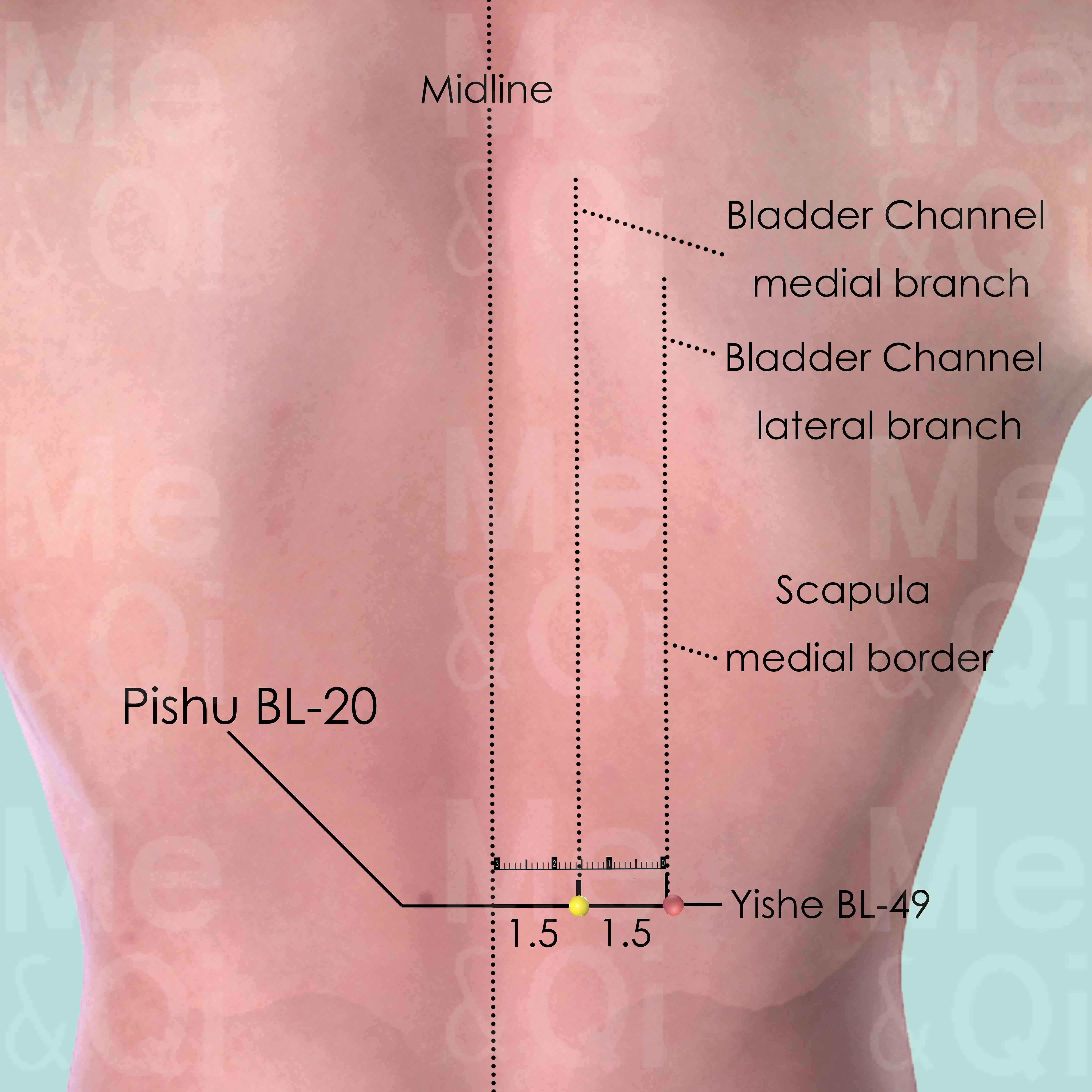
Pishu BL-20
1.5 cun lateral to the lower border of the spinous process of the 11th thoracic vertebra (T11).
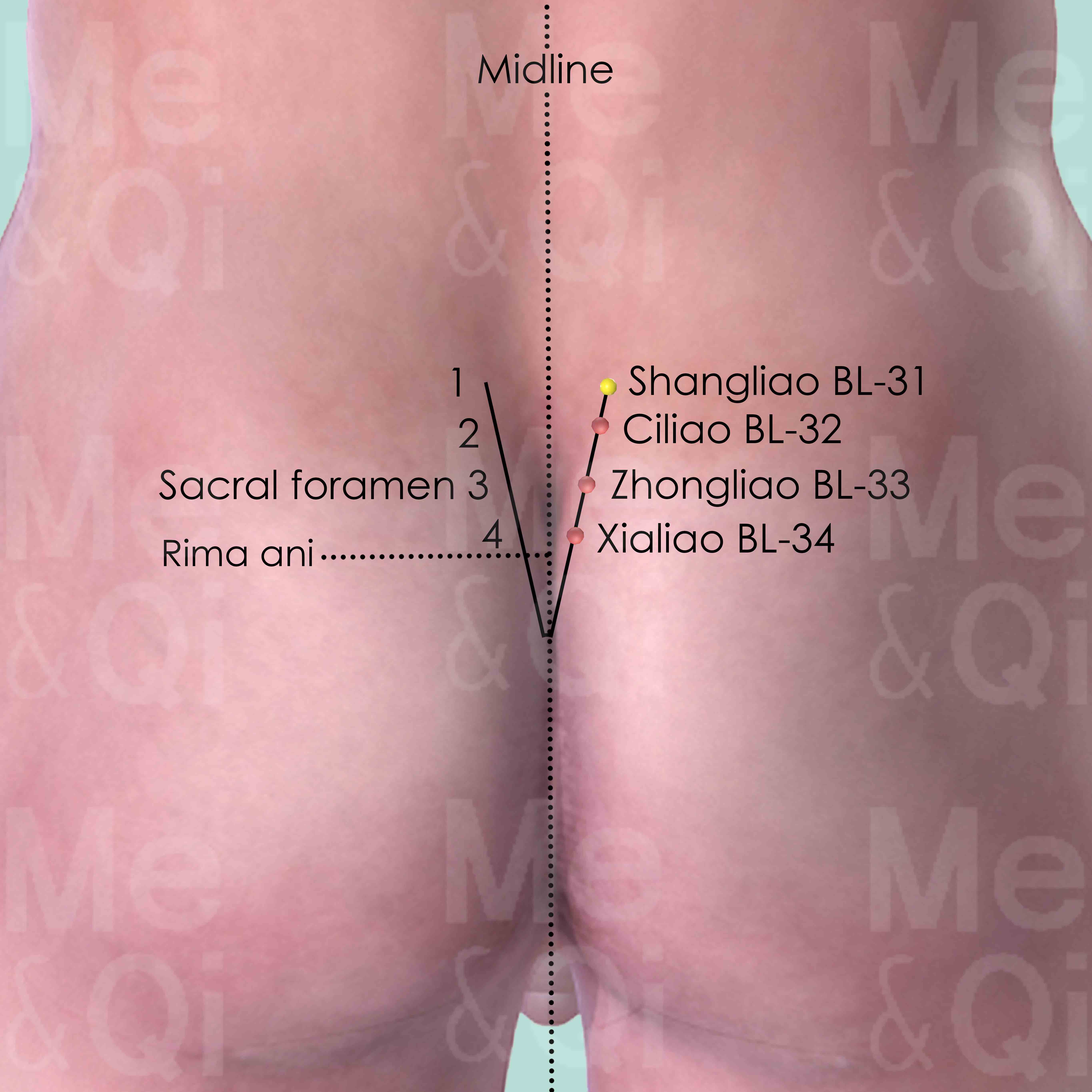
Shangliao BL-31
In the 1st posterior sacral foramen, about midway between the posterior superior iliac spine (PSIS) and the midline.
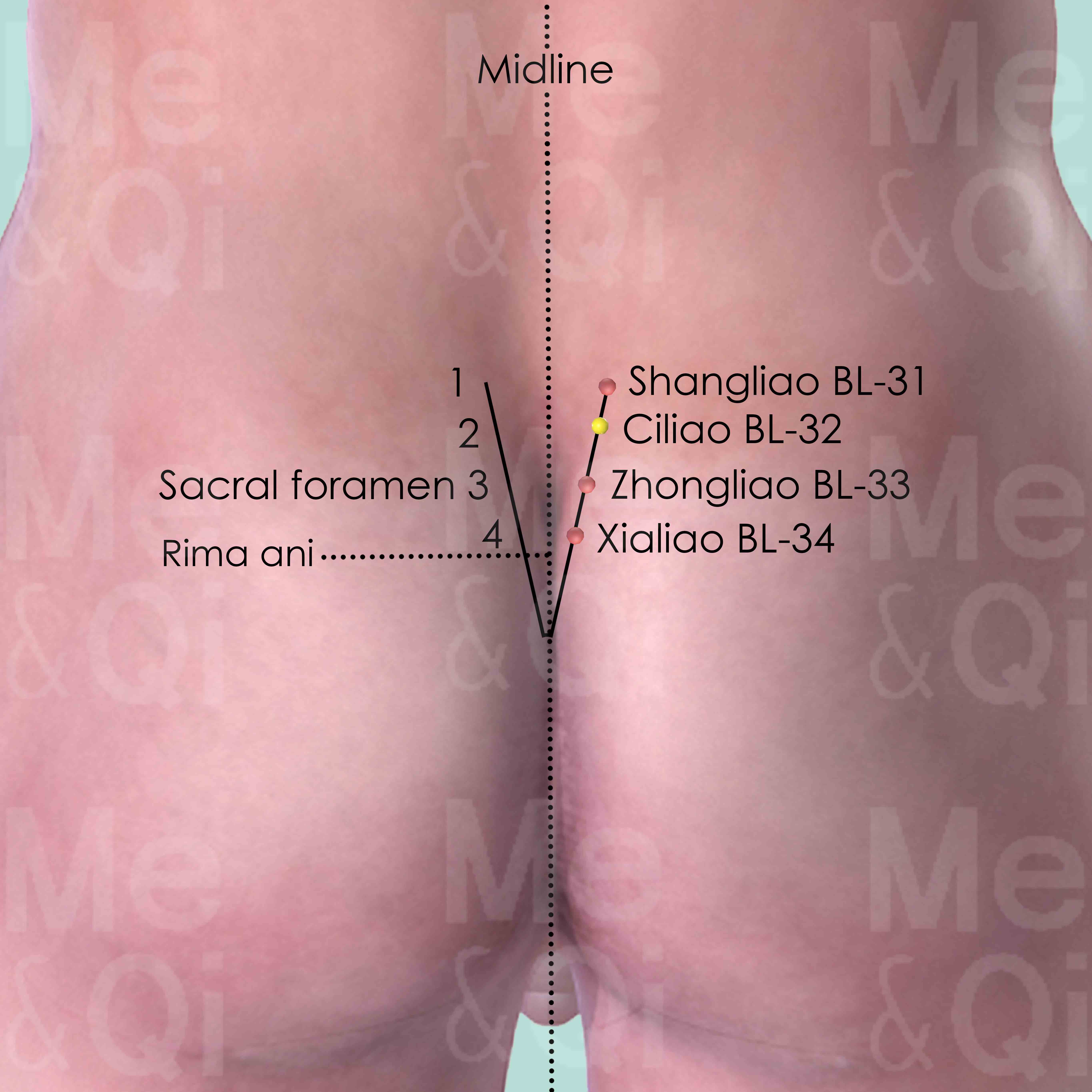
Ciliao BL-32
In the 2nd posterior sacral foramen, about midway between the posterior superior iliac spine (PSIS) and the midline.
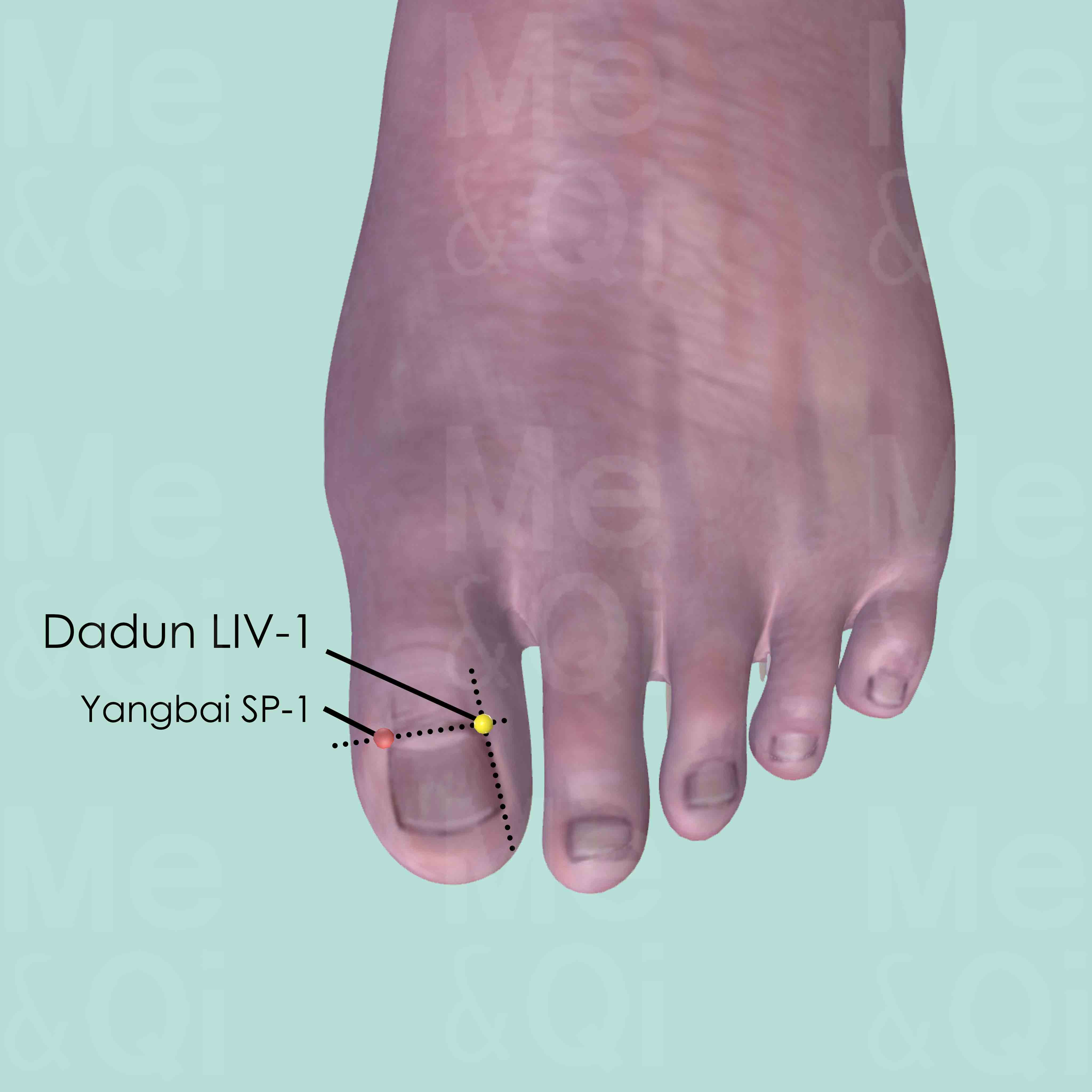
Dadun LIV-1
On the lateral side of the dorsum of the great toe terminal phalanx, between the lateral corner of the nail and interphalangeal joint.
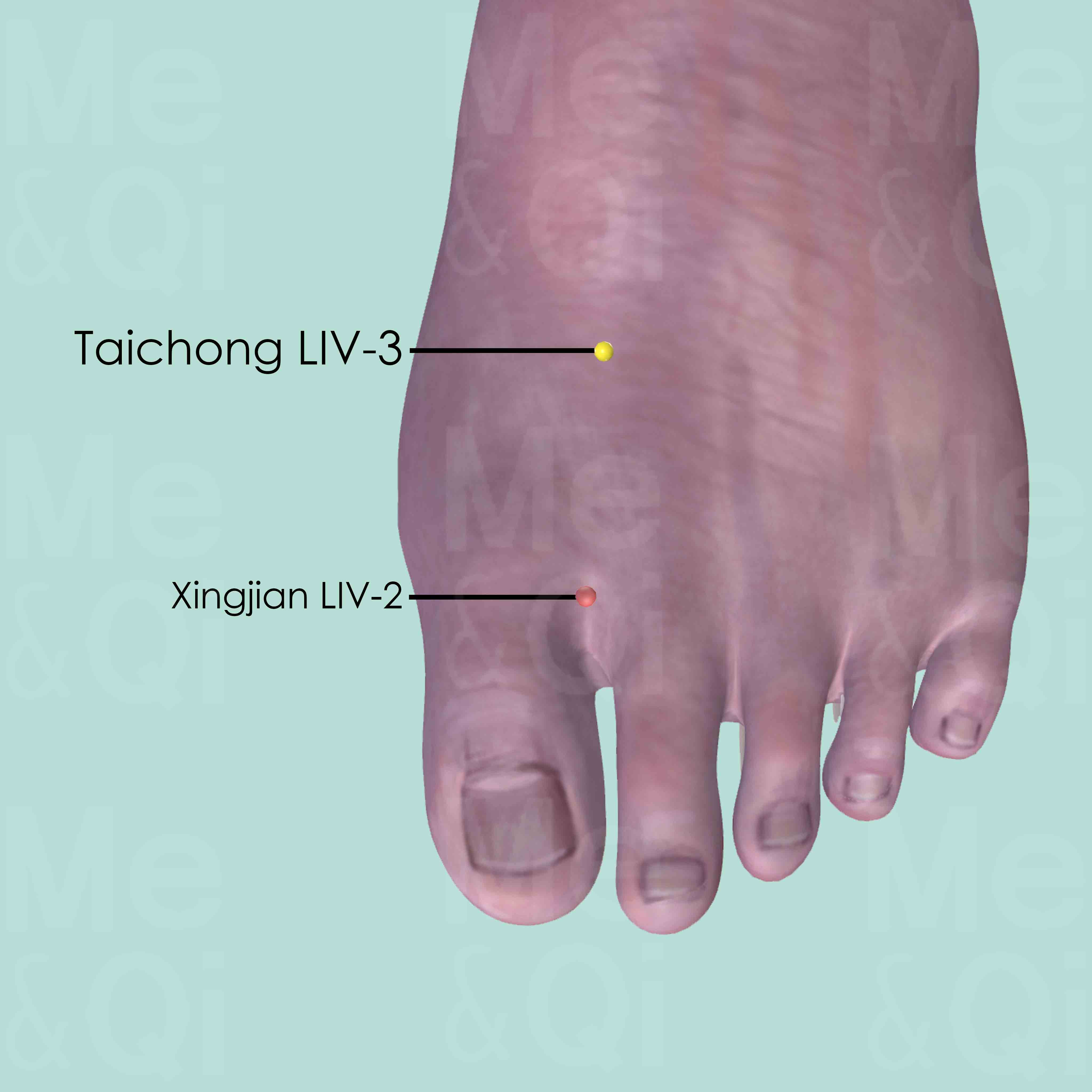
Taichong LIV-3
On the dorsum of the foot, between the 1st and 2nd metatarsal bones, in the depression proximal to the metatarsophalangeal joints and the proximal angle between the two bones.
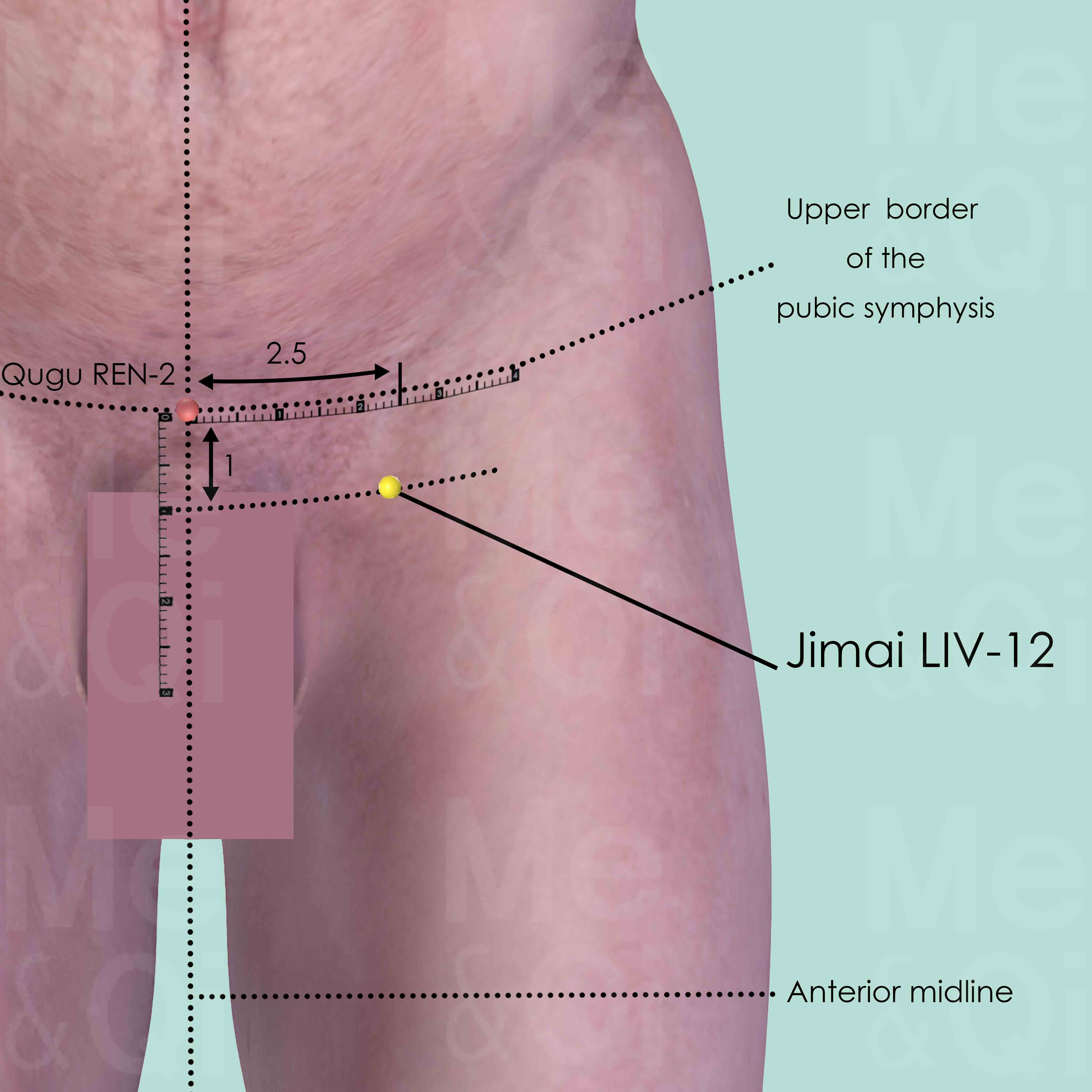
Jimai LIV-12
Interior and lateral to the pubic spine, 2.5 cun lateral to the Qugu REN-2 on the anterior midline and 1 cun inferior to the upper border of the symphysis.
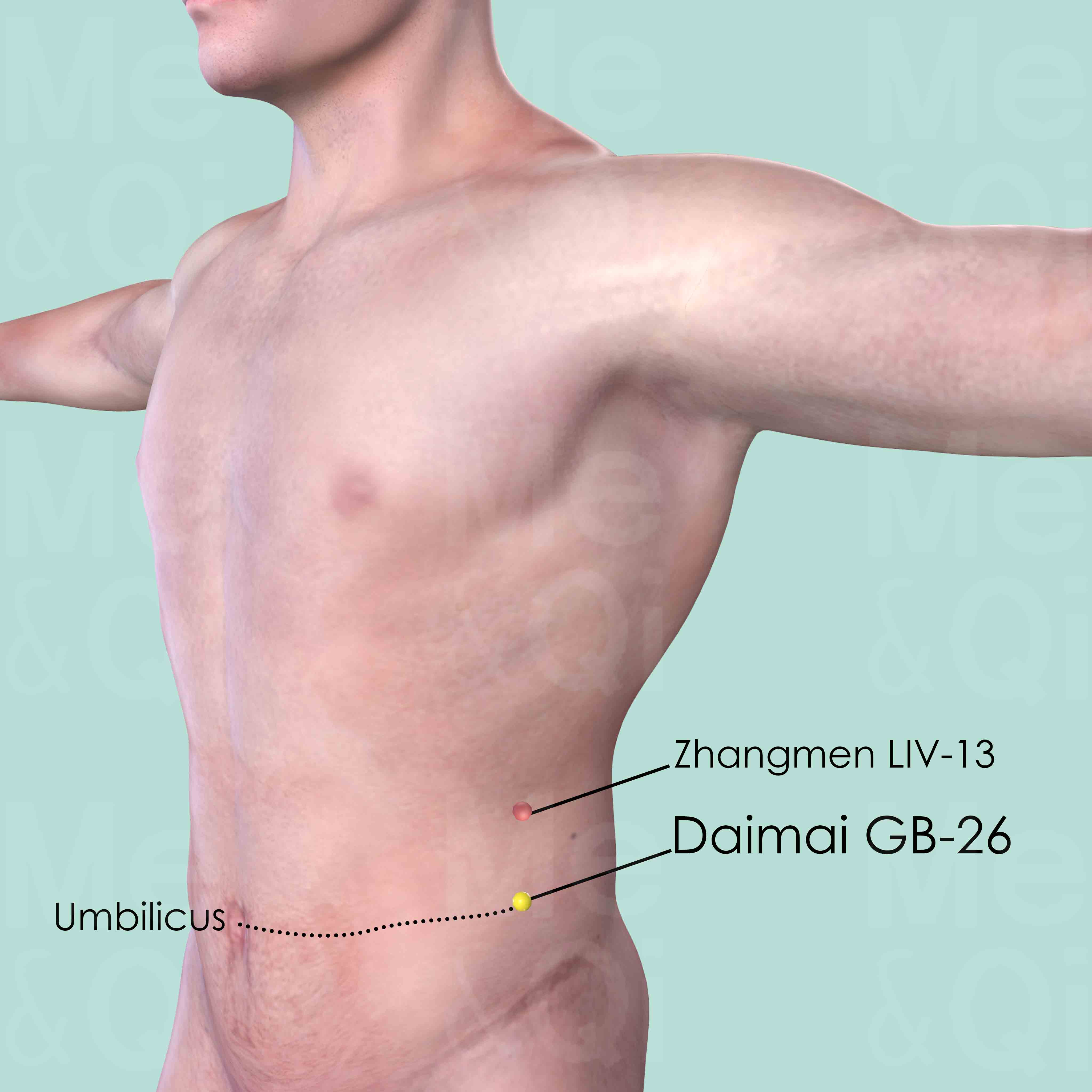
Daimai GB-26
Level with the umbilicus, directly below Zhangmen LIV-13 which is on the free end of the 11th rib.
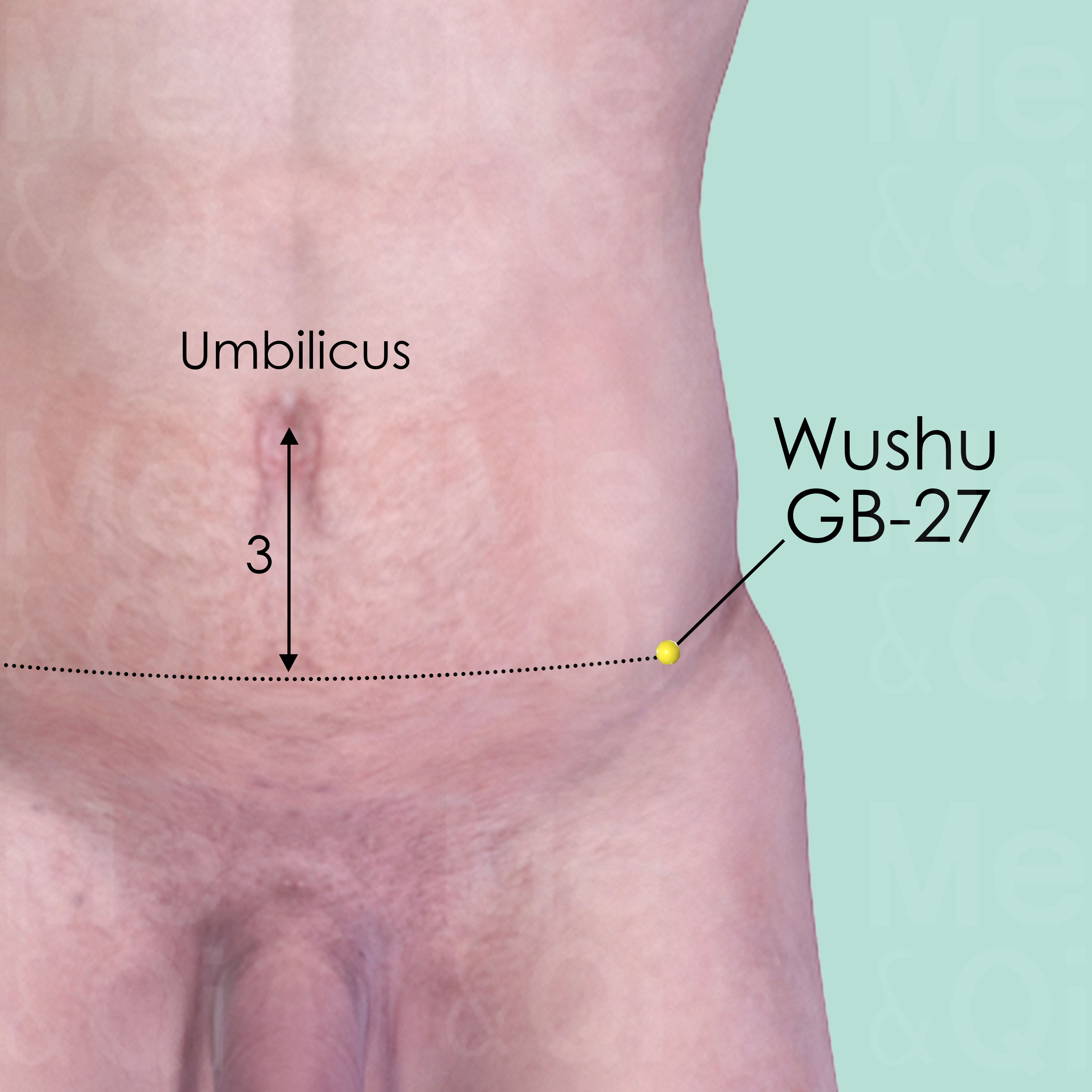
Wushu GB-27
In the lateral side of the abdomen, in the front of the anterior superior iliac spine (ASIS), 3 cun below the level of the umbilicus.
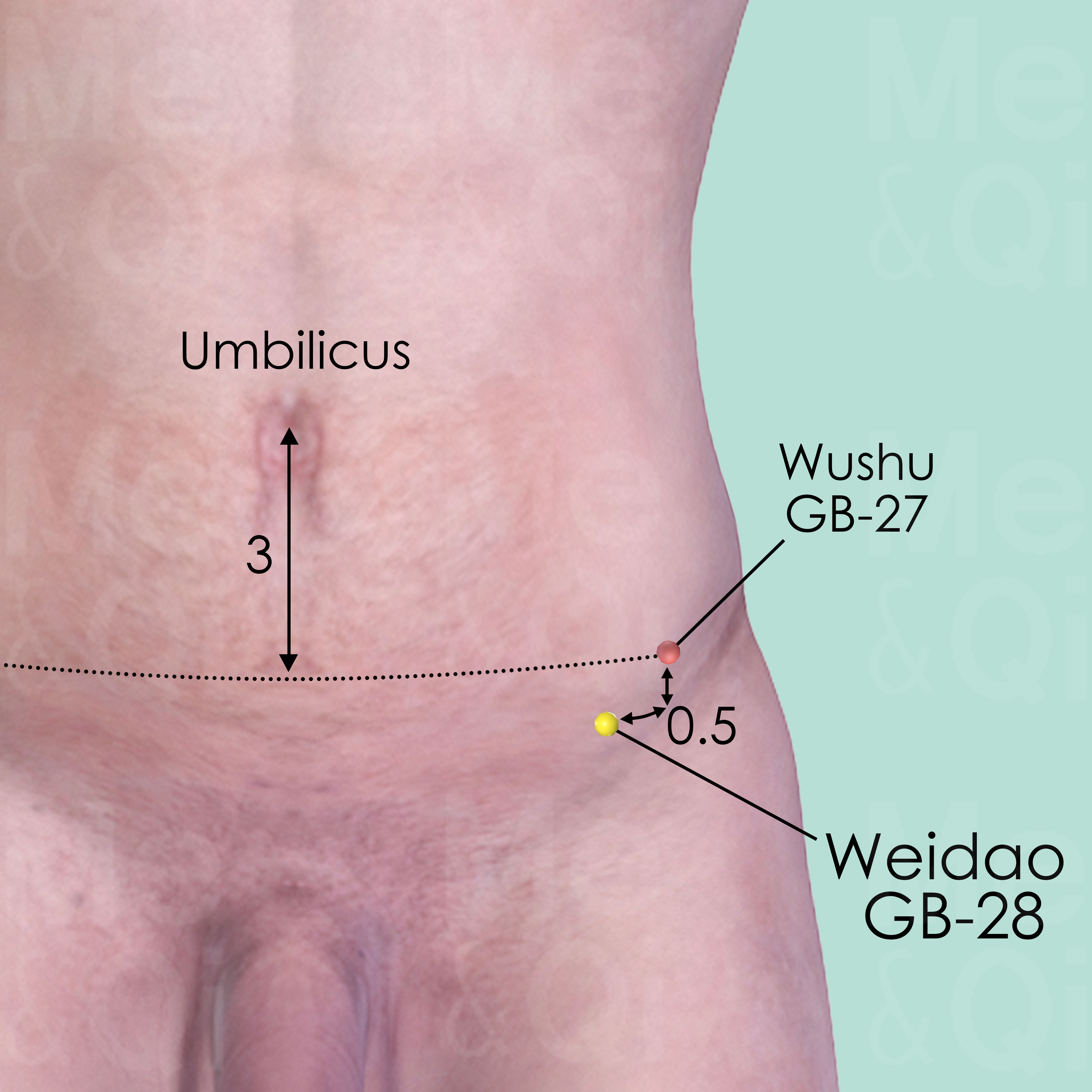
Weidao GB-28
Anterior and Inferior to the anterior superior iliac spine (ASIS), 0.5 cun anterior and inferior to Wushu GB-27.
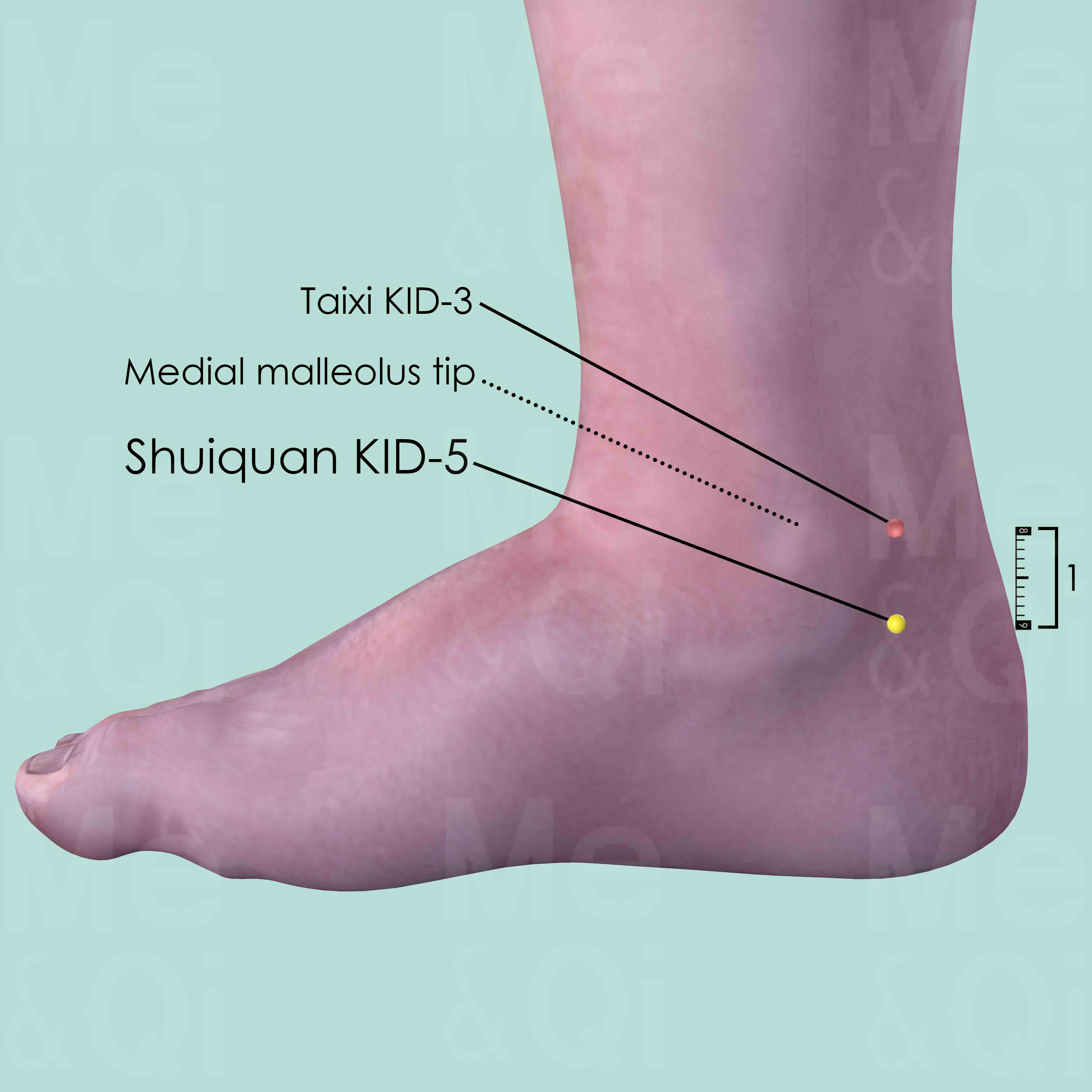
Shuiquan KID-5
1 cun directly below Taixi KID-3, in the depression over the joint space between the talus and calcaneus.
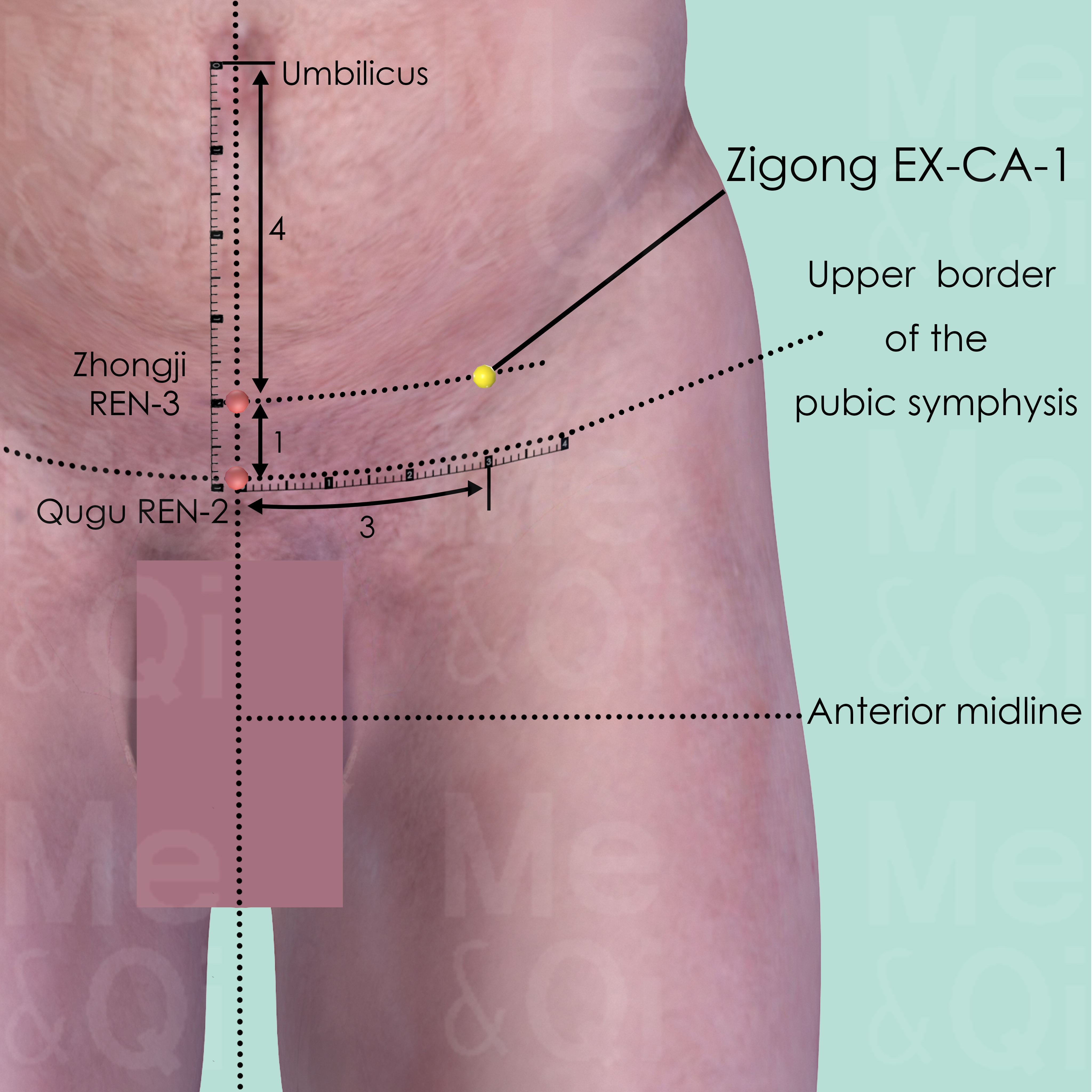
Zigong EX-CA-1
3 cun lateral to the anterior midline and 1 cun superior to the upper border of the pubic symphysis.
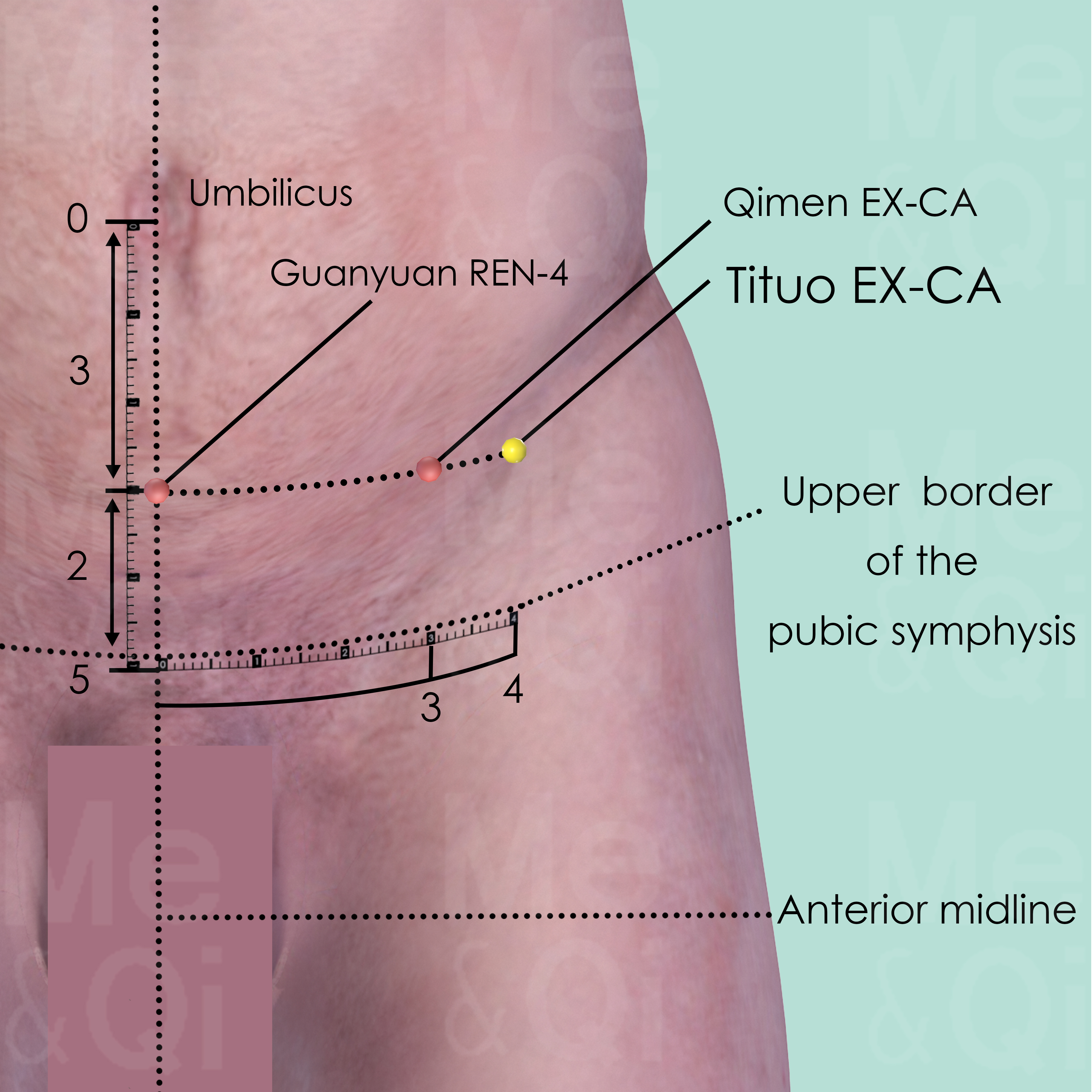
Tituo EX-CA
4 cun lateral to the anterior midline and 2 cun superior to the upper border of the pubic symphysis.
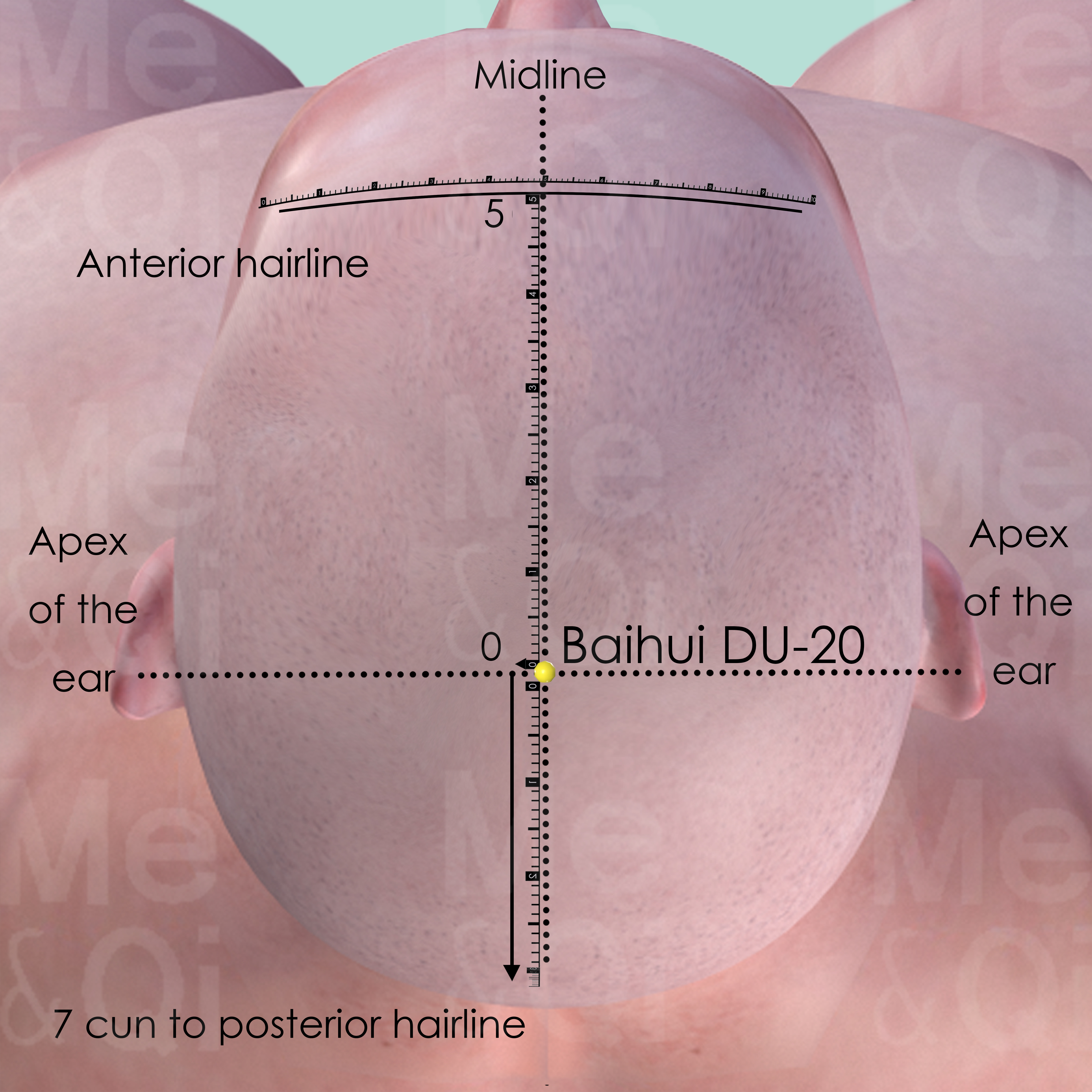
Baihui DU-20
At the vertex, at the junction of a line connecting the apex of the ears and the midline, in the depression 7 cun above the posterior hairline and 5 cun behind the anterior hairline.
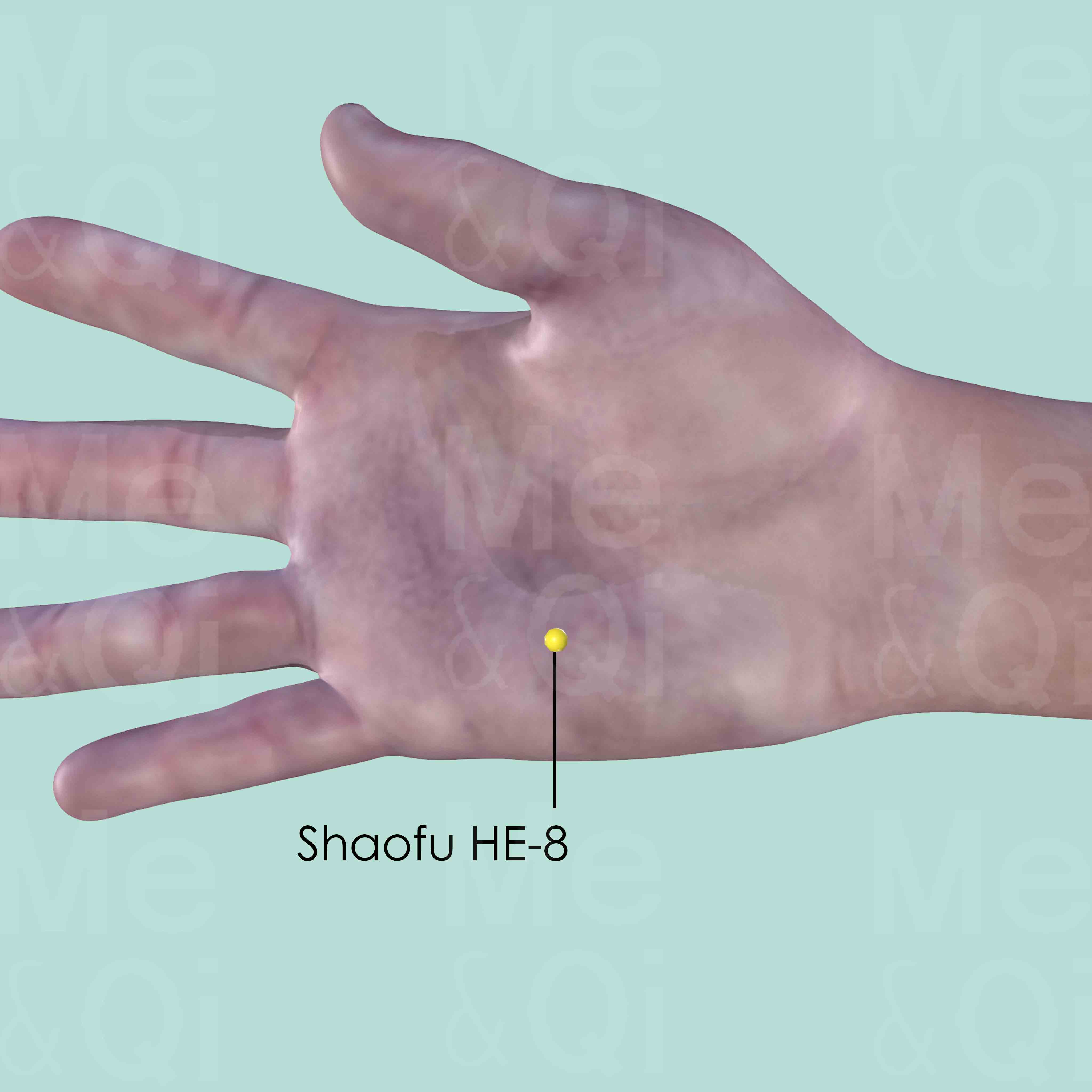
Shaofu HE-8
On the palmar surface, between the 4th and 5th metacarpal bones. When a fist is made, the point is where the tip of the little finger rests.

